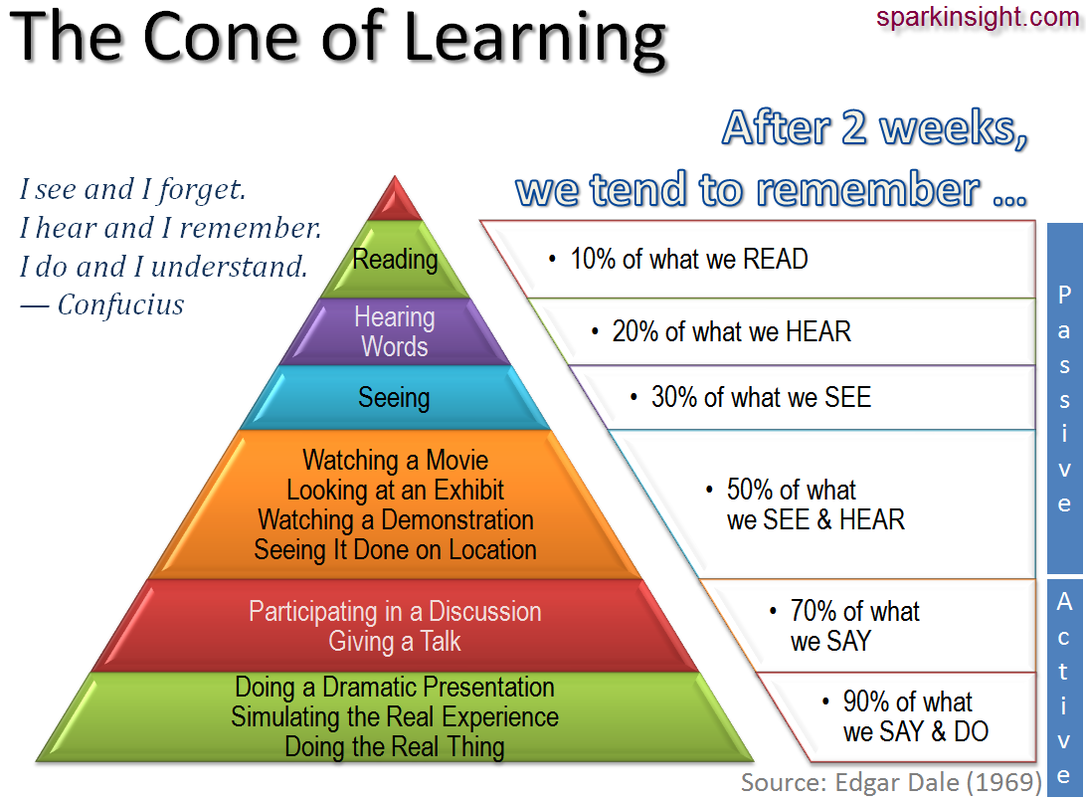The following are reviews of several different web apps that can be used in the classroom to varying degrees of success. For ease of reading and use, each app will include the types of learning under Bloom's Taxonomy and Dale's Cone of Experience that can be used in each.
 |
| Bloom's Taxonomy |
 |
| Dale's Cone of Experience and possible applications of it |
App # 1: Instagram
Instagram is a popular image sharing social media app. It is a platform that is already familiar to many students. It hasn't quite reached the market penetration of Facebook, but among Middle School students at least, it is much more popular for the moment. Instagram by nature is an app that would work best when students are allowed to create new things. The video and photo creation and sharing functions can allow students to create photos and videos and post them. This is not where the app ends though. Bloom's Taxonomy can also be applied to knowledge building and analysis through the social network function. Students can research certain topics (usually limited to current events since George Washington wasn't known for his social media prowess). Most news organizations and businesses maintain a presence on Instagram and comments can allow students to engage in debate with each other and others around the world, although undertaking debates with strangers online can be risky at times.
Within Dale's Cone of Experience, almost all levels of learning can be addressed through Instagram. Students can read short segments of information and follow links to larger sources, hear words being used contextually through videos, watch virtual demonstrations or exhibitions, participate in discussions, and provide their own performances or recreations of important events. As with any tool, Instagram can be used to great effect or be a waste of time depending on how students are expected to use it. There can be a great deal of pointless marketing, self promotion and other less academic topics to wade through, but there is strong potential for Instagram's use in education.


Wikispaces is an open learning management system that is free for individual teachers to sign up for. There is a cost for larger scale use of the program. If you are experienced in using wiki based tools, it is easy to use and implement anything you need to. For the teacher looking to have a ready made "plug and play" type of system for delivering content, it does feature a bit of a learning curve. For teachers looking for a sandbox app that they can customize in many ways, it is a great choice. For those who don't Google Classroom, Schoology, and other more structured apps may be a better choice.
Within Bloom's Taxonomy, teachers can use Wikispaces to facilitate every level of learning from knowledge to creation. Since Wikispaces is a repository for teacher content, it is up to the teacher to decide what should be included. If the teacher wants to assess student knowledge, it is easy to create assessments using the tools within the app. If the teacher wants students to create something new, there are tools that allow this to be assigned and turned in, but teachers will most likely need to link to another app for the actual creation of the project. Also included in Wikispaces are discussion board tools which can allow for analysis and application of learning as well as collaboration between students.
Dale's Cone of Experience is also well met by this app. It can be used for lower level retention activities like reading: It is very easy to post a reading assignment and add in a few questions to assess basic understanding. There is greater potential in the higher retention activities from Dale's Cone. Discussions, collaboration, peer teaching, and other high functioning ways of learning can all be facilitated through Wikispaces. Unlike Instagram, teachers can provide a controlled environment for safe discussions and collaboration.
App 3: Venngage
Venngage is an app that allows students and teachers to create high quality graphic organizers using premade templates or custom creation tools. These charts can be easily posted to social media accounts, turned in using a learning management system, printed, or inserted into presentations. The downside is that this is "freemium" app, where the majority of templates and some advanced features are not available without paying for them.
Venngage allows students to use higher level thinking under Bloom's Taxonomy. While lower level thinking can also be demonstrated through reproducing knowledge or showing understanding, Venngage encourages students to create something new and analyze information through representing it in graphical form.
Likewise, Venngage is best suited to the higher levels of effectiveness under Dale's Cone of Experience. Students can discuss, debate, and use information in new forms with Venngage which, according to Dale offers the best rates for retaining information.
App 4: Podomatic
Podomatic is a podcasting curation app. Anyone can create a channel and upload podcasts to it. Users can also create playlists of different podcasts and organize them in to categories. There is also a social element where you can follow friends and see their podcasts as well. Where Podomatic runs into problems is when students go to create a podcast. There is no creation tool other than the ability to upload and host a podcast on the Podomatic website. In order to actually record, another app is required. There is also no control for the type of content that users are able to access which may limit the usefulness of the app to elementary and middle school teachers where issues could arise from controversial or explicit content.
Taken alone, Podomatic is best suited for finding new sources of information and building knowledge along with possibly discussing and analyzing information through the social component. Paired with a recording app, there is more opportunity for higher level thinking. There are a number of free voice and music recording apps that can be accessed by anyone. With this addition the creative possibilities are endless (as long as they are audio based).
Dale's Cone of Experience similarly can be applied to Podomatic. Without the addition of recording tools and discussions using the social component, students are only able to listen to information which will not result in high retention of information. With the addition of recording tools, students can record discussions, do dramatic performances, and participate in many other higher order thinking activities.

No comments:
Post a Comment